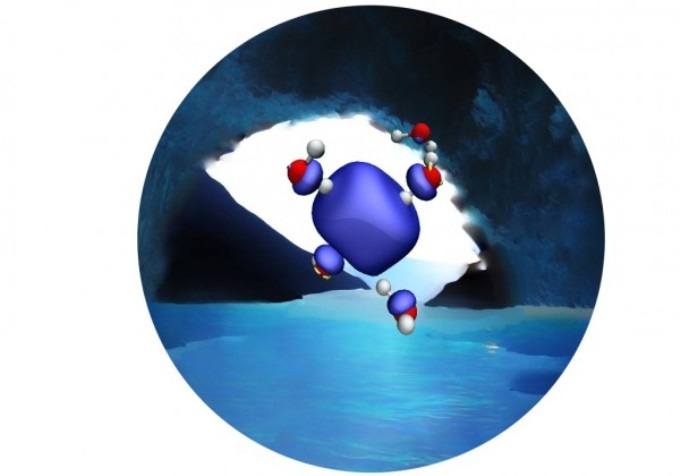Mar 25 2019
For over five decades, researchers have been aware of the existence of the hydrated electron—additional electrons dissolved in liquid water. However, they have not been so certain about its structure.
 A novel MD simulation provides conclusive evidence in favor of a persistent tetrahedral cavity made up of four water molecules. (Image credit: Vladimir Rybkin)
A novel MD simulation provides conclusive evidence in favor of a persistent tetrahedral cavity made up of four water molecules. (Image credit: Vladimir Rybkin)
At present, MARVEL scientists at the University of Zurich, ETH, and the Swiss National Supercomputing Center CSCS have taken a long stride toward solving the puzzle. Their paper, titled “Dynamics of the Bulk Hydrated Electron from Many‐Body Wave‐Function Theory,” has been published as a Very Important Paper in Angewandte Chemie.
It is challenging to directly observe the e−aq species since it is short-lived and cannot be concentrated or separated. This makes it tough to use diffraction, direct structural approaches, or NMR spectroscopy to investigate its structure. Despite that certain properties such as spectra in infrared and ultraviolet regions and the binding energy have been observed directly, the overall dearth in direct experimental measurements of the structure of the hydrated electron makes a hypothesis necessary.
However, credible modeling of the hydrated electron is more or less as difficult as the experimental strategy and the drawbacks of the computational strategies used thus far have resulted in substantial theoretical uncertainty. For instance, scientists have been unable to come to a consensus on whether or not a cavity is occupied by the hydrated electron. Despite the fact that a majority of the theoretical studies propose that it occupies a cavity, non-cavity models have also observed to be accurate. Another point of debate concerns the bulk structures and the distinguishable surface of the hydrated electron.
In the study, scientists Vladimir Rybkin and Jan Wilhelm from the University of Zurich and Joost VadeVondele at ETH Zurich and CSCS employed the first molecular dynamics simulation of the bulk hydrated electron based on correlated wavefunction theory to offer absolute proof supporting the existence of a stable tetrahedral cavity formed of four water molecules. They also demonstrated that there exist no stable non-cavity structures in the bulk hydrated electron.
Through cautious consideration of the properties to be possessed by the most accurate strategy, the scientists arrived at their model. They intended it to be based on molecular dynamics to capture the dynamic and formation transformations of the cavity. In order to eliminate delocalization error and to permit the correlation effects that have been observed to be critical in predicting the dissolution of the electron precisely without empirical parameters, they required a many-body correlated electronic structure level. They desired the simulation to be carried out in the bulk under periodic boundary conditions to prevent the formation of the surface structure and, eventually, the technique should offer an exact description of liquid water.
The MD simulation developed by them—the first-ever dynamic simulation of a complex chemical species in the condensed phase at the correlated wave function level of theory—satisfies all of these demands. This was the initial crucial step. The second was, in fact, to manage to perform it. Computations such as these have been technically not feasible until latest progress—such as those made in their own groups—have enabled extremely parallel many-body theory computations in the condensed phase on sophisticated supercomputers such as those as CSCS. However, nearly 1 million node hours were needed on the Piz Daint supercomputer—Europe’s fastest supercomputer.
The model demonstrated that a cavity is developed in less than 250 fs following the addition of the excess electron to the unperturbed liquid water. Most crucially, the simulation could not find any evidence of the bulk hydrated electron’s non-cavity structures in metastable or stable states—offering considerably stronger theoretical evidence for the cavity model.
NCCR MARVEL funded this study.